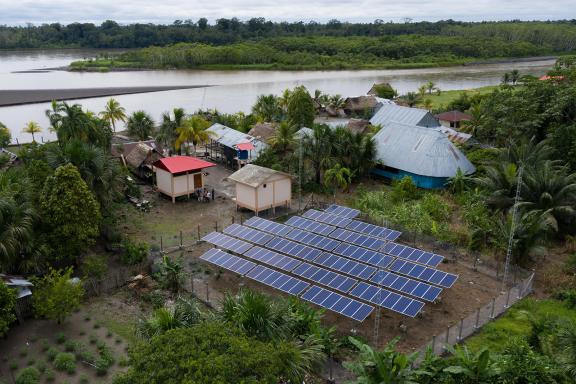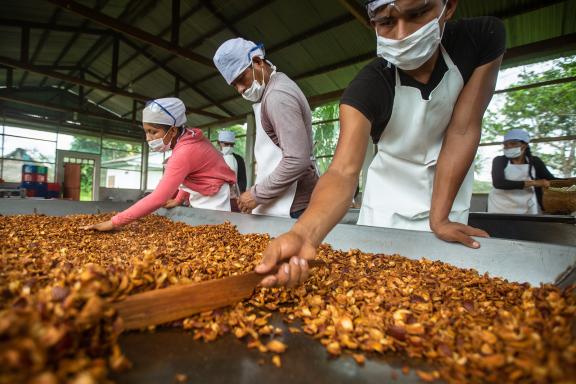Overview
By storing some 123 billion tonnes of carbon, the Amazon plays a crucial role in global climate regulation. It also is home to more than 30 million people, providing numerous Indigenous Peoples and local communities with livelihoods, a safety net against poverty, and the means to ensure resilience against climate change.
But only up to a point: recent research suggests that the Amazon is on the verge of turning from a carbon sink (i.e., a net absorber of atmospheric carbon) into a source due to sustained high rates of deforestation and forest degradation. More worryingly, scientists have alerted the world to the risk of pushing the Amazon to a tipping point. According to this scenario, the Amazon would flip into a landscape of non-forest ecosystems, suddenly releasing a large proportion of carbon into the atmosphere and dramatically accelerating climate change globally.
The COVID-19 pandemic also revealed the extreme vulnerability of the Amazon’s population to health threats. The virus spread across the 7.5 million km² forest within weeks, reaching isolated communities at record speed and causing important casualties because of limited access to health care.
Data on this page as of 9 August 2022
GCF’s vision for the Amazon
As the world’s largest tropical forest with a massive carbon storage capacity, the Amazon basin is a key priority for the Green Climate Fund (GCF). In addition, one of the Amazon’s strongest comparative advantages is its capacity to deliver not only on mitigation through reduced or avoided emissions, but also on adaptation along with a wide range of co-benefits. These include, but are not limited to, biodiversity with its three million species; water security since the Amazon holds 20 per cent of the world’s flowing freshwater; and sustainable livelihoods for millions.
The Amazon also acts as one of the world’s most diverse repositories of indigenous and traditional cultures for whom the forest has priceless spiritual value. Any mitigation and adaptation activities in the Amazon must not only avoid all harm for these peoples and communities but also enhance their health and well-being and help scale up the positive relationships that many have developed with their surrounding environment for centuries.

Photo: Profonanpe/Gustavo Carrasco
GCF has unleashed the full range of its financial instruments – grants, concessional debt, equity, guarantees, and results-based payments – across the Amazon in a variety of settings and activities to ensure the conservation of some of the world’s highest-value forests, sustainable management of timber and non-timber forest resources, and restoration of degraded ecosystems.
As it prepares for its second programming cycle starting in 2024, GCF will be placing an ever-increasing emphasis on partnerships – with the Global Environment Facility and its Amazon Sustainable Landscapes Program and the Long-Term Vision (LTV) it shares with GCF; with the private sector and its ability to unlock finance at scale; and with Indigenous Peoples and local communities and their crucial role in protecting this unique ecosystem.
Status of GCF support to the countries of the Amazon
Where: GCF currently supports Brazil, Bolivia, Colombia, Ecuador, Guyana, Peru, and Suriname through GCF’s proposal approval process (PAP), Simplified Approval Process (SAP), REDD+ results-based payment pilot programme, and Readiness programme, as integral elements of the countries’ efforts to implement the Paris Agreement and achieve the Sustainable Development Goals.
Total GCF commitment: As of August 2023, GCF has committed over USD 671 million to date to nature-based solutions across the countries of the Amazon Basin, avoiding more than 327 million tonnes of anticipated carbon dioxide equivalent (mtCO2eq) and enhancing the climate resilience of more than 32 million beneficiaries. This includes:
- The Amazon Bioeconomy Fund aimed at providing grants, loans, equity and guarantees to sustainable small and large bio-businesses across the Amazon through multiple, tailor-made financing windows, including one specialised for smallholders and indigenous communities;
- Supporting REDD+ Readiness and implementation, and providing the world’s first REDD+ results-based payments for emissions reductions achieved by Brazil, Ecuador, and Colombia under the REDD+ pilot programme during the 2014-2018 period;
- Direct access support through national partners, notably the Peruvian Trust Fund for National Parks and Protected Areas (Profonanpe), to local eco bio-businesses in the Peruvian Amazon;
- Private sector initiatives such as the multi-country Arbaro Fund aimed at reducing emissions by sustainably growing timber to reduce pressure on natural forests; and
- Providing catalytic capital for adaptation and climate-smart agriculture for an integrated approach to sustainability in the Amazon.

Photo: Profonanpe/Marlon del Aguila Guerrero Tarapoto
Pipeline: GCF’s pipeline includes a variety of transformative proposals for the Amazon, totalling another half billion US dollars in GCF resources and a further USD 964 million in co-financing. These include projects on indigenous livelihoods in the Peruvian Amazon, enhancing the climate resilience of Brazil’s public health system, supporting the expansion and protection of Colombia’s exceptional network of protected areas, establishing a tropical landscape facility, and supporting the development of sustainable cocoa agroforestry.
Projects in the Amazon
For multi-country proposals, components from countries other than those composing the Amazon Basin were excluded. In cases where country breakdowns were not available, figures were split equally across participating countries.












